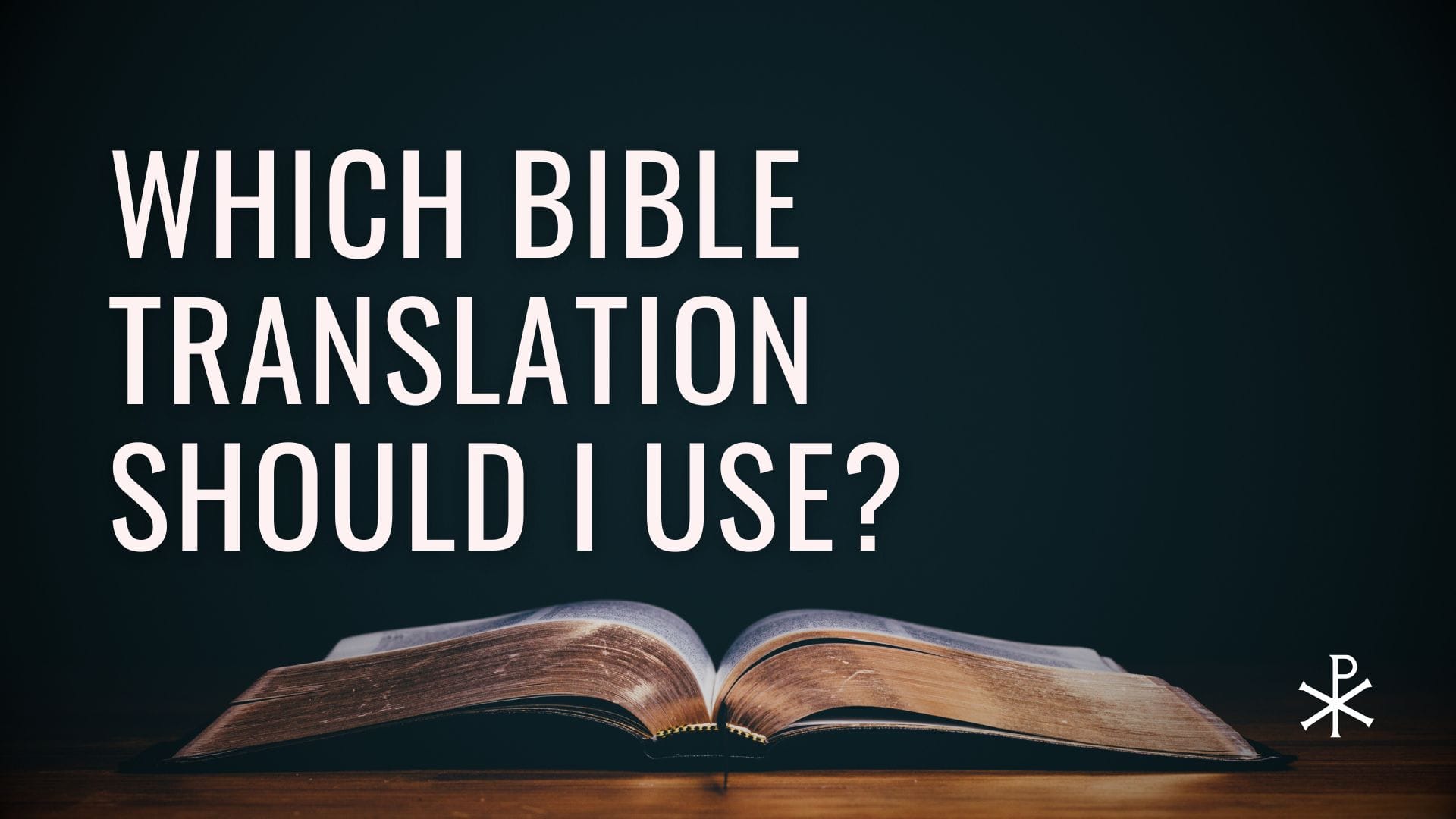Which Bible Translation Should I Use?
A clear, trustworthy guide to choosing a Bible translation, explaining manuscript evidence, translation philosophies, and why we can be confident we’re reading God’s Word.

Christians love the Bible because it is God's Word. But peruse a bookstore shelf or a Bible app and you’ll immediately face a question: which translation should I use? With so many available, it can feel overwhelming. The good news is that English-speaking Christians today are unusually blessed. Never in history have so many faithful, carefully produced translations been available to ordinary believers.
Manuscripts and Modern Translations
The Bible was originally written in three ancient languages: Hebrew, Aramaic, and Greek. None of the original parchments survive, but what we do have is extraordinary: thousands of ancient manuscripts copied and passed down through the centuries. These include fragments dating within a generation or two of the apostles, entire books and collections from the early church, and later manuscripts that have preserved the text with remarkable care.
When scholars compare these manuscripts, they find an extraordinary level of consistency. Variations do exist, but the vast majority are minor, things like spelling differences or word order that don’t affect meaning. Where questions remain, the evidence is weighed carefully and transparently, with notes often included in the margins or footnotes of your Bible. Taken together, this mountain of manuscripts points us reliably back to the original writings (the “autographs”), giving us every reason to trust that what we hold in our hands is truly the Word of God.
To put this in perspective, consider how the New Testament compares with other works from antiquity. We possess more than 5,000 Greek manuscripts of the New Testament, with some fragments dating to within decades of the originals. By contrast, the works of Plato survive in fewer than a dozen manuscripts, most copied over a thousand years after he lived. Julius Caesar’s Gallic Wars exists in about ten good manuscripts, with a gap of nearly a millennium between the events and our earliest copies. No historian seriously doubts whether Plato or Caesar wrote what is attributed to them. If we apply the same standard, the New Testament stands on rock-solid ground.
Modern translations are produced by large teams of scholars who compare these manuscripts, weighing the evidence carefully. They are not working in the dark. On the contrary, today we have far more manuscript evidence than was available to earlier translators. That’s one reason newer translations sometimes read slightly differently than older ones. The goal is not to change the Bible but to reflect as accurately as possible what the biblical authors actually wrote.
A Word on the Textus Receptus and Critical Text
One reason translations differ lies in the base manuscripts used. The King James Version and the New King James Version are based on the Textus Receptus (“Received Text”), a Greek New Testament compiled in the 16th century from a handful of late manuscripts. At the time, that was the best evidence available.
Since then, thousands of earlier manuscripts have been discovered, some dating within a century of the apostles. Modern translations such as the ESV, NIV, CSB, and NASB use what’s called the critical text, which weighs this fuller range of evidence. The result is not a different Bible but a text that reflects more ancient witnesses. The differences are minor, well-documented in footnotes, and do not alter any doctrine of the Christian faith.
Two Main Approaches to Translation
Once the manuscripts are in view, translators face a question of philosophy: how to render the inspired text into English. Two broad approaches stand out.
Formal Equivalence (Word-for-Word)
Seeks to stay as close as possible to the wording and structure of the original. Excellent for study and careful reading, though sometimes less smooth in English.
- English Standard Version (ESV) - this is my preferred translation
- New American Standard Bible (NASB, 1995 and 2020 editions)
- New King James Version (NKJV)
- King James Version (KJV, historic but dated in language)
Dynamic Equivalence (Thought-for-Thought)
Seeks to capture meaning in natural English rather than mirror the exact words. Often more readable, especially for new readers.
- New International Version (NIV)¹
- Christian Standard Bible (CSB)
- New Living Translation (NLT)
Paraphrase
A paraphrase is less a translation than a restatement. It can be vivid and devotional but is best used as a supplement, not your main Bible, if at all.
- The Message (Eugene Peterson)
- The Living Bible
¹ A brief note on the NIV: many Christians came to faith with the 1984 edition, and it remains one of the most widely used translations in the world. Later editions (2011 onward) updated certain renderings, particularly in gender-related language. Some find these changes helpful; others believe they blur the precision of the original text. Personally, I prefer the 1984 edition for its clarity and faithfulness, though the later NIV is still within the bounds of faithful evangelical translation.
A Sample Comparison
Sometimes it helps to see the differences in practice. Take John 1:14:
- ESV (formal): “And the Word became flesh and dwelt among us, and we have seen his glory, glory as of the only Son from the Father, full of grace and truth.”
- NASB (formal): “And the Word became flesh, and dwelt among us; and we saw His glory, glory as of the only Son from the Father, full of grace and truth.”
- CSB (dynamic): “The Word became flesh and dwelt among us. We observed his glory, the glory as the one and only Son from the Father, full of grace and truth.”
- NIV (dynamic): “The Word became flesh and made his dwelling among us. We have seen his glory, the glory of the one and only Son, who came from the Father, full of grace and truth.”
- NLT (dynamic/paraphrastic): “So the Word became human and made his home among us. He was full of unfailing love and faithfulness. And we have seen his glory, the glory of the Father’s one and only Son.”
Each is recognizably the same verse. The differences are in shading: “dwelt” versus “made his dwelling,” “one and only Son” versus “only Son.” None of these alter the meaning, but they illustrate the different priorities of translation philosophy.
Readability Matters Too
It’s worth noting that different translations aim at different reading levels. The NASB is demanding, often requiring careful, line-by-line study. The ESV sits at a solid middle range, readable yet accurate. The NIV and CSB are more conversational and accessible. The NLT is the simplest, ideal for younger readers or those new to the Bible. None of these are less “God’s Word.” They are simply tuned for different readers.
Who Does the Translating?
Another reassurance: reputable translations are not the work of a lone scholar imposing his view on the church. They are produced by committees of evangelical scholars, often representing a range of denominations, who check and balance one another’s work. That collaborative process helps guard against theological bias and ensures that accuracy and clarity remain the driving concerns.
The Clarity of God’s Word
Sometimes when people hear about manuscripts, philosophies of translation, or differences between versions, they begin to worry: can I really trust my Bible? The answer is a resounding yes. The differences between faithful translations are minor, never touching the core doctrines of the faith. The essential message of Scripture is clear. God has preserved His Word, and the Spirit still speaks through it with power.
Choosing a Translation
Because every translation involves choices, no single version can perfectly capture all the nuances of the original languages. That’s why many pastors and teachers encourage reading more than one good translation. A more literal version anchors you to the structure of the text; a more dynamic version brings clarity and flow. Read together, they complement one another.
In my own reading and preaching, I most often use the English Standard Version. I find it balances accuracy with readability in a way that serves both study and worship. But I am also grateful for the NIV, NASB, CSB, NKJV, KJV, and others. All of these are faithful, evangelical translations produced with great care.
The Bottom Line
The most important thing is not which faithful translation you choose, but that you actually open it and read it. God’s Word is living and active. It convicts, comforts, and transforms. Thanks to the extraordinary manuscript evidence God has preserved, and the labors of careful scholars and translators, English-speaking Christians can trust that when we open a modern translation, we are truly hearing God’s Word.
So don’t be paralyzed by choice. Select a good translation, read it daily, and let the Word of Christ dwell in you richly.
Further Reading (Affiliate Links):
- D.A. Carson, The King James Version Debate
Carson offers a clear, charitable, and scholarly response to the “KJV-only” movement, explaining why no single translation should be elevated as uniquely inspired. He surveys the history of the biblical text, the science of textual criticism, and the strengths and weaknesses of various translations. His goal is not to disparage the King James Bible but to call Christians to confidence in God’s Word as preserved across faithful translations, and to realism about the limits of any one version. - Leland Ryken, The Word of God in English
Ryken, a longtime literature professor and stylistic consultant for the ESV, makes the case for essentially literal (word-for-word) translation as best suited for accuracy, clarity, and reverence in handling Scripture. Drawing on principles of language, literary style, and theology, he critiques dynamic equivalence approaches and argues that preserving the form of the original text honors both the divine Author and the church’s need for reliable Scripture.
Bibles (Affiliate Links):
Formal Equivalence (Word-for-Word)
Dynamic Equivalence (Thought-for-Thought)
We often use clearly-marked affiliate links here for products and services we personally enjoy. This includes Amazon links, as well as other partnerships as clearly noted. If you make a purchase through these links, we may receive a small commission at no extra cost to you. Thank you for supporting our work in this way.
